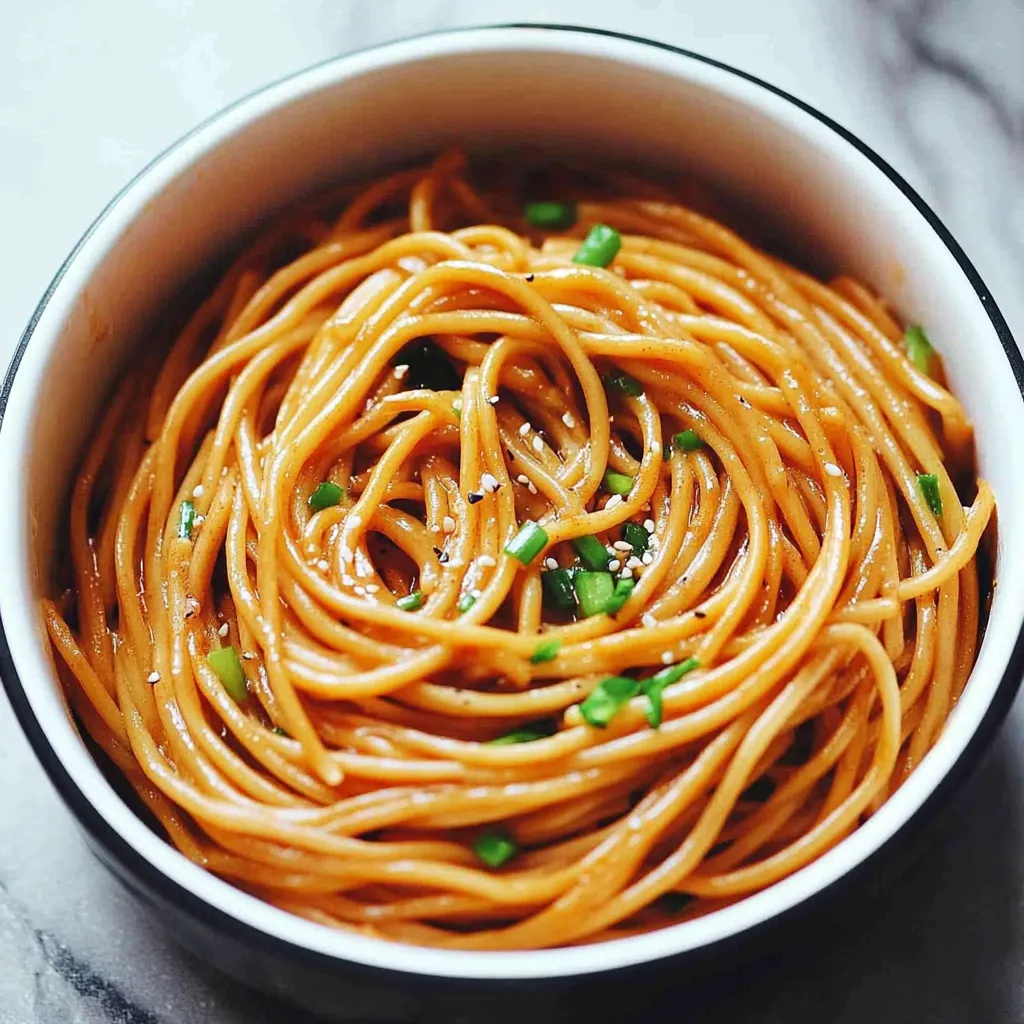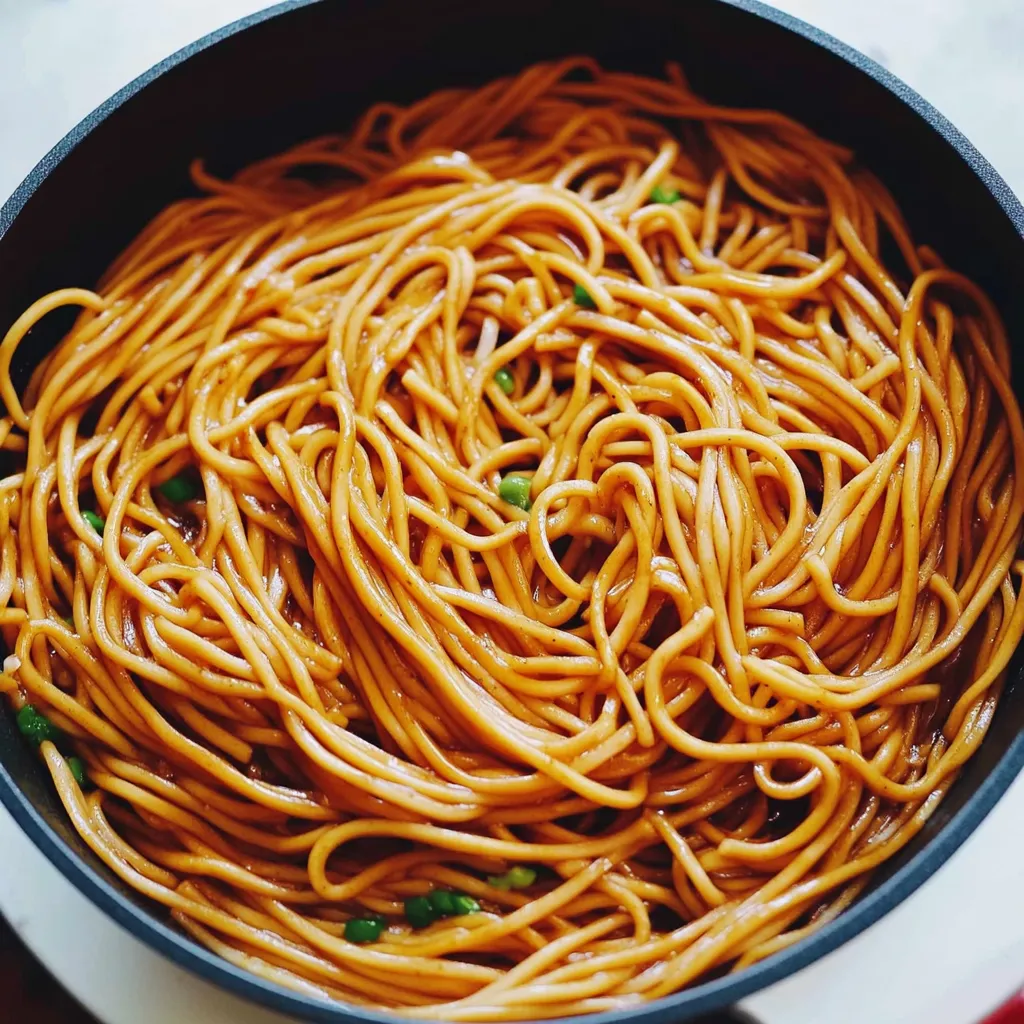 Pin it
Pin it
These buttery hibachi noodles deliver all the savory, umami-rich flavors of your favorite Japanese steakhouse right in your own kitchen using simple ingredients you probably already have. The combination of garlic, ginger, and soy sauce creates an irresistible sauce that coats every strand of noodles, while sesame oil and fresh scallions add those authentic finishing touches that make this taste restaurant-quality. Unlike complicated Asian noodle dishes that require hard-to-find ingredients, this recipe works beautifully with regular linguine pasta, proving that authentic flavors can come from accessible substitutions.
I started making these noodles when my family became obsessed with hibachi restaurants but we couldn't always justify the expense of eating out. The first time I served them, my kids were amazed that I could recreate those beloved flavors at home, and now these noodles have become our go-to side dish whenever we want to make dinner feel special without a lot of fuss.
Essential Ingredients and Selection Tips
- Linguine or yakisoba noodles: Choose high-quality pasta that holds its shape well; fresh yakisoba noodles are ideal but dried linguine creates nearly identical results
- Fresh garlic cloves: Use plump, firm cloves without green shoots; fresh garlic provides the sharp, aromatic base that pre-minced versions can't match
- Fresh ginger: Look for smooth, tight skin without wrinkles; ginger paste works well for convenience but fresh grated ginger has more vibrant flavor
- Low-sodium soy sauce: This allows you to control the saltiness while providing that essential umami depth; tamari works perfectly for gluten-free needs
- Brown sugar: Light brown sugar balances the salty soy sauce with gentle sweetness; avoid dark brown sugar which can overpower the delicate flavor balance
- Sesame oil: Use pure sesame oil, not blended varieties, for authentic nutty flavor; a little goes a long way so use sparingly
- Fresh scallions: Choose bunches with bright green tops and firm white bottoms; both parts contribute different flavor notes to the finished dish
- Salted butter: Real butter creates much better flavor than margarine and helps create the silky sauce texture
The key to perfect hibachi noodles is building the sauce slowly to develop deep flavors, then tossing the noodles gently to coat them without breaking them apart.
Detailed Step-by-Step Instructions
- Step 1: Cook the noodles properly:
- Bring a large pot of salted water to a rolling boil and cook your linguine or yakisoba noodles according to package directions until just al dente - they should have a slight bite since they'll cook a bit more in the sauce. Drain immediately and rinse with cool water to stop the cooking process and prevent sticking.
- Step 2: Prepare all aromatics:
- While the noodles cook, mince the garlic finely and grate the fresh ginger (or measure out ginger paste). Slice the scallions, separating the white and light green parts from the dark green tops - you'll use them at different stages for maximum flavor impact.
- Step 3: Heat the pan and create the base:
- In a large non-stick skillet or wok, melt the salted butter over medium heat until it stops foaming and begins to smell nutty. Add the minced garlic, grated ginger, and white parts of the scallions along with a pinch of salt to help release their flavors.
- Step 4: Build the aromatic foundation:
- Cook the garlic and ginger mixture for 2-3 minutes, stirring constantly to prevent browning and burning. The mixture should become very fragrant and the garlic should soften completely - this creates the flavor base that will coat the noodles.
- Step 5: Create the sauce:
- Add the soy sauce, brown sugar, and 2-3 tablespoons of water to the aromatic mixture. Stir everything together and let it simmer for 2-3 minutes until the brown sugar dissolves completely and the sauce begins to thicken slightly, coating the back of a spoon.
- Step 6: Add the noodles carefully:
- Add the drained, cooled noodles to the skillet and use tongs or chopsticks to gently toss them with the sauce. Work carefully to avoid breaking the noodles, lifting and folding them through the sauce rather than stirring aggressively. Continue tossing for 2-3 minutes until every strand is evenly coated.
- Step 7: Finish with flavor enhancers:
- Remove the pan from heat and immediately drizzle with sesame oil, starting with 1 teaspoon and adding more to taste. Add a squeeze of fresh lemon juice to brighten all the flavors, then taste and adjust seasoning with additional salt and pepper if needed.
- Step 8: Final garnish and serve:
- Sprinkle the reserved dark green scallion tops over the noodles for color and fresh flavor contrast. Serve immediately while hot, as the noodles are best when the sauce is still silky and coating each strand perfectly.
 Pin it
Pin it
The most important technique is keeping the heat at medium to prevent the garlic from burning and building the sauce gradually so all the flavors meld together properly before adding the noodles.
This recipe has become such a family favorite because it proves that restaurant-quality flavors don't require expensive ingredients or complicated techniques. My husband, who's usually skeptical of my attempts to recreate restaurant dishes, admitted these noodles taste exactly like what we get at our favorite hibachi place, which was the ultimate validation.
Understanding Asian Flavor Profiles and Balance
The magic of hibachi noodles lies in achieving the perfect balance of salty, sweet, savory, and aromatic elements that characterize authentic Asian cuisine. Soy sauce provides the essential umami base and saltiness, while brown sugar adds just enough sweetness to balance without making the dish cloying. Garlic and ginger create the aromatic foundation that gives depth, while sesame oil provides that distinctive nutty finish that signals authentic Asian flavors. The lemon juice serves as the acid component that brightens everything and prevents the dish from feeling too heavy or one-dimensional.
Noodle Selection and Cooking Techniques
While yakisoba noodles are traditional, the principles of this recipe work with various noodle types because the technique focuses on proper sauce adhesion rather than specific noodle characteristics. The key is cooking noodles just until al dente, as they'll continue cooking when tossed with the hot sauce. Rinsing the noodles after cooking serves two purposes - it stops the cooking process and removes excess starch that could make the final dish gummy. The gentle tossing technique prevents breaking the noodles while ensuring even sauce distribution.
Sauce Development and Consistency Control
Building the sauce in stages allows each flavor component to develop properly before combining with the others. Starting with the aromatics in butter creates a flavorful fat base that carries flavors throughout the dish. The soy sauce and brown sugar combination needs time to meld and slightly reduce, creating the proper consistency that will cling to noodles without being too thick or too thin. The small amount of water helps dissolve the brown sugar and creates the right sauce texture for coating.
Heat Management and Timing Strategies
Proper heat control is crucial throughout this recipe to prevent burning the delicate aromatics while still developing deep flavors. Medium heat provides enough energy to cook the garlic and ginger properly without risking burning, which would make the entire dish bitter. The timing of adding each component matters - aromatics first to build the base, then liquids to create the sauce, then noodles when the sauce is ready, and finally the finishing touches off the heat to preserve their bright flavors.
Storage and Reheating Best Practices
Hibachi noodles can be stored successfully, though they're undeniably best when fresh. The key to successful reheating is adding moisture back to prevent the noodles from drying out and restoring some of the original sauce consistency. Using a combination of butter and sesame oil during reheating helps revive the original flavors, while the addition of water creates steam that gently reheats the noodles without making them mushy. Cover the pan during reheating to trap steam and ensure even heating throughout.
These hibachi noodles have become my go-to proof that authentic flavors don't always require authentic ingredients - sometimes it's all about understanding the flavor principles and applying good technique to whatever you have available. Every time I make them, I'm reminded that the best home cooking often comes from adapting restaurant techniques to work with everyday ingredients and equipment.
Frequently Asked Questions
- → Can I use regular pasta instead of yakisoba noodles?
- Yes, linguine, spaghetti, or fettuccine work great as substitutes for yakisoba noodles.
- → How long do these noodles take to make?
- The entire recipe takes 15 minutes - 5 minutes prep and 10 minutes cooking time.
- → What makes these noodles taste like hibachi?
- The combination of butter, garlic, soy sauce, brown sugar, and sesame oil creates that signature hibachi flavor.
- → Can I make these noodles ahead of time?
- These noodles are best served fresh and hot, but you can reheat leftovers in a pan with a little extra butter.
- → What should I serve with hibachi noodles?
- They pair perfectly with grilled chicken, steak, shrimp, or vegetables for a complete hibachi-style meal.
- → Are hibachi noodles spicy?
- No, these noodles are not spicy. They have a sweet and savory flavor that's mild and family-friendly.
